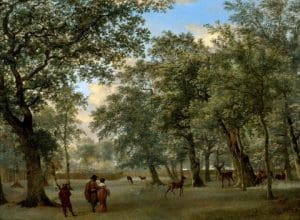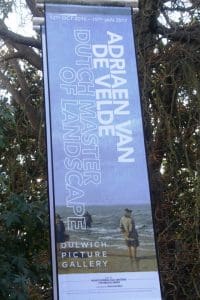
The beach at Scheveningen, 1658. Oil on canvas. © Museumslandschaft Hessen Kassel, Gemäldegalerie Alte Meister.
Dulwich Picture Gallery celebrates Adriaen van de Velde, master of landscape of the Dutch Golden Age
By James Brewer
He was the son of one of the greatest Dutch marine painters, and his older brother excelled in the same genre, but Adriaen van de Velde secured his own fame by ploughing a different furrow.
Adriaen devoted his marvellous facility with the paintbrush (and red, black and white chalk) to depicting the human figure and his country’s real and imagined landscapes.
While his contemporaries gloried in the Golden Age, a long period when the Dutch led the world in trading (with the powerful Dutch East India Company), shipping and shipbuilding, Adriaen van de Velde (1636-1672) found his ideals and inspirations in the farmland and countryside a short distance from his home in the great port city of Amsterdam.

Figures in a deer park c 1665. Oil on panel. Museum of Fine Arts, Houston,
the Edward and Sally Speelman Collection.
He may have thought that two superb marine painters in two generations were enough, but he must have benefited from their skills and savoir-faire. Soon in artistic terms, he became his own man – in fact, he became his own teenager as he displayed precocious talent.
Dulwich Picture Gallery has installed a tribute to this genius with its latest temporary exhibition (until January 15 2017) Adriaen van de Velde: Dutch Master of Landscape. This is essentially a transfer of the first major retrospective of his work at the Rijksmuseum from June to September 2016.
Adriaen loved the cloud colorations of the heavens. He would have appreciated the wide skies above the London suburb of Dulwich, a near-bucolic (apart from motor traffic) area of Greater London, which is helping revive his fame.

Bart Cornelis, curator.
Guest curator Bart Cornelis has done a hugely impressive job of piecing together from sketchy documentary evidence and artistic detective work a biography of van de Velde and his relations with other significant painters of the age. He maintains Dulwich’s admirable record of concise, legible and informative labelling and commentary.
Born into a family of seascape painters, Adriaen van de Velde was baptised in Amsterdam in November 1636. His father was the noted marine painter Willem van de Velde the Elder (1611-1693) and brother the equally renowned marine specialist Willem van de Velde the Younger (1663-1707). Adriaen, who almost certainly never travelled outside Holland, is in modern times less well known than his father and brother, both of whom spent the last years of their life in London.

Figures on the beach at Scheveningen, 1660. Oil on canvas. Royal Collection Trust. C Her Majesty Queen Elizabeth 2015.
Willem the Elder had been born in Leiden, the son of a Flemish merchant and inland barge master, Willem Willemsz van de Velde. Making good use of his shipping heritage, he rose to become the official artist of the Dutch fleet and naval battles, but with Willem the Younger moved to London in 1672, coinciding with the period shortly after the death of Adriaen and a downturn in the Dutch economy. Willem the Younger was celebrated for marine and coastal scenes and the Wallace Collection in London has some of his works.
Adriaen was probably first taught by his father, but turned away from marine themes. Mr Cornelis says it is unclear where he received further training; some sources have said that he did, from Jan Wijnants, but the latter was only five years older. It is not usually clear who was influencing who in the artistic circles of the time, although Paulus Potter was certainly a role model, as van de Velde was ‘Potteresque’ in his clever depiction of cattle.

Herdsman and herdswoman with livestock by a stream. Pen in brown and black grey wash. Teylers Museum, Haarlem.
Adriaen, who can be considered a child prodigy, must have realised quite early that there were enough seascape painters on hand. Although in his images (such as The Beach at Scheveningen of 1658, oil on canvas, loaned by Gemäldegalerie Alte Meister, Kassel) of vast spaces “just how they are” he is not too far from what his father and brother were doing, he went on to focus on both Dutch-style and Italianate views of appealing landscapes with peasants and better-off individuals content with their lot, and happily domesticated animals – one of the dogs even dozes off ahead of a hunt.
He collaborated occasionally with his brother by adding figures and animals to a beachscape. In subsequent works, the spotlight is firmly on the human figures, and by means of the angle he adopts, the sea is pushed to the background. In his early 20s Adriaen was showing superb mastery and was “almost 19th century in his sensibility,” according to Mr Cornelis, who is a former deputy editor of The Burlington Magazine.
In distancing himself from the great sea pictures produced by the family stable, Adriaen forged his career essaying all sorts of subjects, “but manages to make all these genres his own,” says Mr Cornelis.
He was such a good figure painter and draughtsman that other artists invited him to populate their landscapes with men and women and animals. It needs huge skill to integrate figures successfully into other people’s paintings.

Seated woman with basket. Red chalk. Private Collection.
Mr Cornelis says that Adriaen’s figures and animals “are almost palpable in their three-dimensional presence.” Such highly-regarded painters as Wijnants, Jacob van Ruisdael, Meindert Hobbema, Jan van der Heyden, Jan Hackaert, Philips Koninck and Frederick de Moucheron entrusted their pictures to him for vital additions. Among the resultant stand-outs is Dulwich Picture Gallery’s Two Churches and a Town Wall(1660s) by van der Heyden, which features in the new exhibition.
We are told that few 17th-century Dutch landscapists devoted so much time and energy as van de Velde to sketching from models in the studio. The exhibition has among the figure work sheet with Two Studies of a Reclining Shepherd (Rijksmuseum), “which in its elegance and exquisite use of red chalk prefigures the work of 18th-century French artists such as Antoine Watteau and François Boucher.”
In April 1657 van de Velde married Maria Ouderkerk in Amsterdam, where he probably remained for the rest of his life. She was Catholic and their children were all baptised in clandestine Catholic churches. He died at the age of 35 and was buried in the Nieuwe Kerk in Amsterdam.
For much of his short life he was regarded as one of the greatest artists of the 17th century, but he was unable to cash in on his reputation. In the 1660s he was doing rather poorly financially, and documents have survived about loans that needed to be repaid. He began to paint landscapes of the sort that took less time to complete than his earlier large works, so that he could offer them quickly for sale. Mr Cornelis writes in the catalogue that there is no evidence that, as some artists did, he was able to pay off his debts by transacting paintings, “but had he done so, his creditors would eventually have done very well out of them.”
His fame endured until the mid-20th century, when he fell out of fashion. In the 18th and 19th centuries he was one of the most sought-after names by rich collectors in Germany, France and England. His paintings became more expensive at auction than those of Rembrandt.
Dulwich and the Rijksmuseum have performed a first-class service in assembling 60 of his most accomplished works and preparatory studies, many of the latter in characteristic red chalk; the whole charting landmarks from his oeuvre of less than two decades. Displayed alongside the paintings, the finely-wrought studies offer a rare glimpse of a 17th-century landscape painter through all the creative phases of his work. There are few other instances of such insights having come down from that era.

Dulwich advertises Adriaen.
Mr Cornelis said: “We can, as it were, look over his shoulder to see how he composed his landscapes. It is exceptional to have so many of his examples where you can follow his work from the preliminary sketch to the worked-out sketch. It gives you such a rare glimpse of how exactly he went about his business.”
For the first time van de Velde’s painting of The Hut (from the Rijksmuseum) is displayed next to the studies that the artist made, such as Seated woman with basket and Resting cow with three sheep (both from Amsterdam Museum), and a drawing of the hut, from a private collection. Mr Cornelis says that these and other examples reveal van de Velde’s almost obsessive attention to detail and how he proceeded from a rough composition sketch in pen and ink to separate studies of animals and figures from life, often in the medium of red chalk and signed.
The exhibition opens with works from the artist’s early 20s, including The Beach at Scheveningen, in which the human activity stands out in the pure light of a summer’s day. In that work a man is staring out to sea – “the direction of his gaze suggests that he is looking out to a vast, endless space invisible to the beholder,” says the exhibition caption.
The curator said the mountainous scenery and Italianate character of some of his landscapes and drawn studies sprang from his imagination and were inspired by the work of fellow artists. Examples include thePastoral scene from the Museo Thyssen-Bornemisza, Madrid, and the preparatory composition drawing for this painting from the Morgan Library & Museum, New York. Especially in his later work van de Velde succeeded in incorporating the sun-drenched atmosphere of Italianate painters such as Karel Dujardin, but brought a refinement to his subjects rarely matched by his contemporaries.
The exhibition concludes with his larger paintings, notably the monumental Portrait of a Family in a Landscape (Rijksmuseum) which was long thought erroneously to refer to the family of van de Velde; andLandscape with cattle and figures (Fitzwilliam Museum, Cambridge). Together these works show a Dutch Arcadia as it was imagined by this exceptionally refined artist, avers Mr Cornelis.
The show includes pen-and-ink drawings and watercolours that the organisers justifiably say stand alone as works of art in their own right. Look out for the overloaded river ferries, as in Landscape with livestock crossing a river (Teylers Museum, Harlem), which is done with brush and watercolour, completed by framing lines in pen and dark brown ink.
Mr Cornelis curated the exhibition in collaboration with Marijn Schapelhouman, senior curator of drawings at the Rijksmuseum.
Works can be seen from institutions including the Royal Collection, Ashmolean Museum, Oxford, Fitzwilliam Museum, Cambridge, Gemäldegalerie Alte Meister, Dresden, the Morgan Library & Museum, New York, Musée du Louvre, Paris, and the National Gallery, London.
Mr Cornelis said: “This exhibition provides an opportunity for the public to get to know the work of one of those exceptionally gifted and refined artists of the Dutch Golden Age who has more recently slipped through the net of history but who deserves to be rediscovered as the great painter and draughtsman that he is.”
Adriaen van de Velde: Dutch Master of Landscape runs until January 15 2017 at Dulwich Picture Gallery, Gallery Rd, Southwark SE21.





